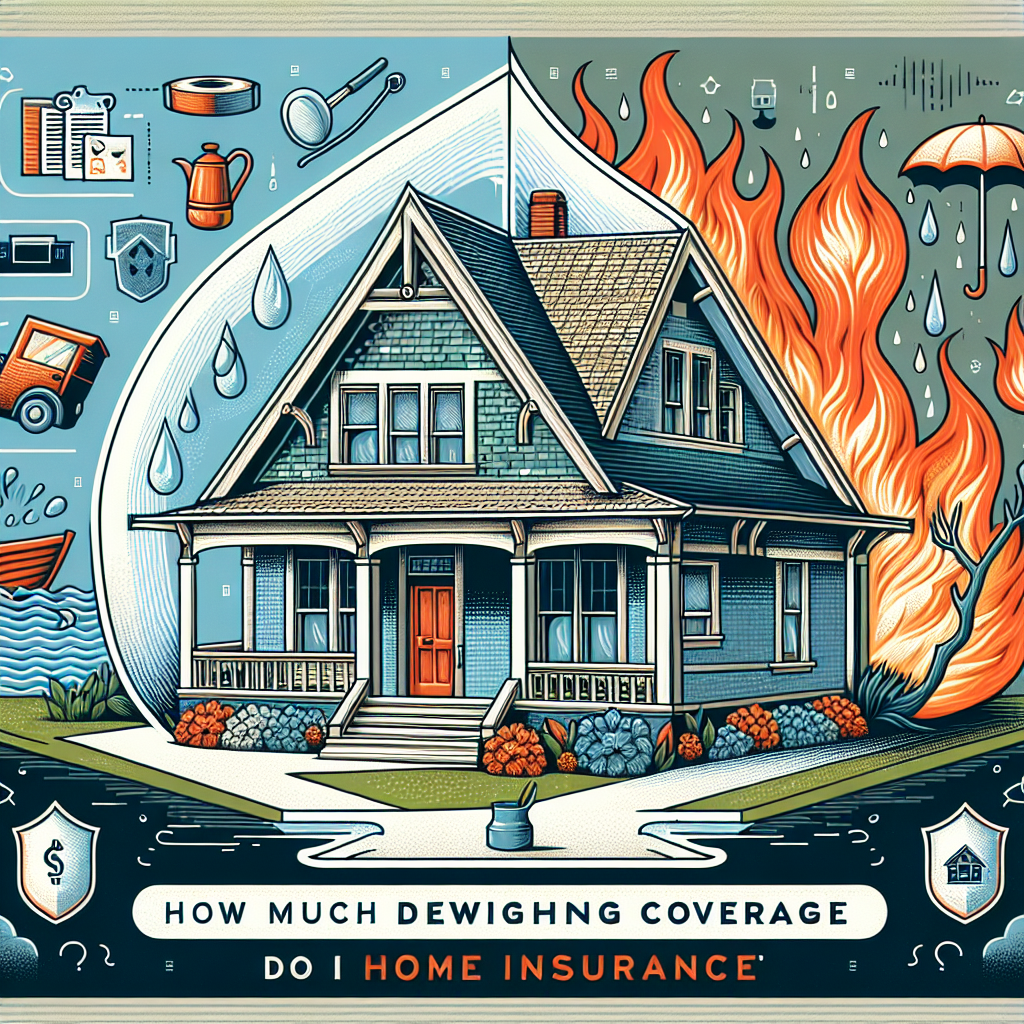Filed under Home Insurance on
How Much Dwelling Coverage Do I Need for Home Insurance

You’ve poured time, money, and memories into your home. Protecting it begins with one crucial number: the amount it would cost to rebuild from the ground up if the worst happened. If you’ve ever asked, “How Much Dwelling Coverage Do I Need for Home Insurance,” you’re not alone. Many homeowners assume the purchase price or mortgage balance is the right benchmark. In reality, what you need is an accurate estimate of replacement cost—the true expense to reconstruct your house with similar materials and craftsmanship at today’s prices. Get that right, and you’ll avoid painful coverage gaps and out-of-pocket surprises.
What Dwelling Coverage Actually Protects
Dwelling coverage (often called Coverage A on a homeowners policy) pays to rebuild the physical structure of your home after a covered loss. Think foundation, framing, roofing, siding, windows, built-in cabinets, and major systems like plumbing, electrical, and HVAC. It generally doesn’t include land value, and it’s separate from other parts of your policy such as:
- Other Structures (Coverage B): Fences, detached garages, sheds.
- Personal Property (Coverage C): Your belongings and household items.
- Loss of Use (Coverage D): Additional living expenses if your home is uninhabitable during repairs.
This is why using the home’s market value is risky. Market value reflects land, neighborhood desirability, school districts, and interest rates. Replacement cost reflects the labor, materials, permits, and professional services needed to reconstruct your house today.
How Much Dwelling Coverage Do I Need for Home Insurance? A Practical Framework
Before you land on a number, ground your decision in three guiding principles:
- Target full rebuild value at today’s prices. Your goal is not what you paid for the home—it’s the current cost to rebuild with like kind and quality.
- Plan for volatility. Labor and material costs can spike after disasters or during supply chain crunches.
- Build in buffers and upgrade allowances. Codes evolve. So do your tastes. Coverage should keep pace.
With that in mind, here’s a streamlined process to determine a solid coverage number.
Step-by-Step: Estimating Replacement Cost
- Measure or confirm square footage. Use tax records, a recent appraisal, or a measured floor plan. Include finished areas above grade; finished basements can be handled differently depending on your carrier.
- Identify construction type and quality. Is your home standard frame construction or masonry? Do you have custom millwork, high-end stone, or engineered hardwood? Architectural complexity matters.
- Find a realistic cost per square foot for your region. For an average single-family home, this might range from roughly $150 to $400+ per square foot depending on location and finish quality. Coastal, urban, and high-wage areas can run higher. Custom or historic homes can exceed $600 per square foot.
- Multiply and adjust for features. Multiply square footage by the cost per square foot, then add adjustments for:
- Complex roofs, cathedral ceilings, or premium windows
- Specialty finishes (stone counters, custom tile, built-ins)
- High-end systems (smart home wiring, radiant heating)
- Unique aspects like a wine room or home theater
- Include “soft costs.” Permits, architectural/engineering fees, surveys, temporary utilities, and project management often add 10%–20% to a rebuild.
- Add debris removal and site work. Demolition, debris hauling, tree removal, and potential grading or foundation work can add meaningful dollars, especially after major losses.
- Account for code upgrades. If your home predates current building codes, rebuilding will require upgrades (seismic ties, hurricane clips, electrical changes). Without an “Ordinance or Law” endorsement, those may not be fully covered.
- Stress-test for inflation and demand surge. After regional catastrophes, labor and material prices jump. Extended or guaranteed replacement cost options help, but don’t under-size your base coverage.
Example: Bringing the Math to Life
Imagine a 2,200-square-foot, two-story home with mid-to-high finish quality in a suburban area where current rebuild costs average $240 per square foot. A basic estimate might look like this:
- Base rebuild: 2,200 sq ft × $240 = $528,000
- Adjustments for premium finishes and complex roof: +$40,000
- Soft costs (15%): +$85,200
- Demolition/debris/site work: +$18,000
- Code upgrades buffer: +$20,000
Estimated replacement cost: ≈ $691,200. In this scenario, you’d set dwelling coverage around $690,000–$700,000, then consider an extended replacement cost endorsement of 20%–50% to absorb price shocks. This is a more reliable way to answer, “How Much Dwelling Coverage Do I Need for Home Insurance” than simply matching your mortgage or listing price.
Why Market Value and Mortgage Balances Can Mislead
Reconstruction is not resale. One includes land and buyer demand; the other includes skilled labor during overtime crunches and materials purchased retail, not wholesale. A few pitfalls to avoid:
- Using purchase price as coverage: If land value made up a big share of your purchase, your replacement cost will be significantly lower—or higher if you bought a fixer-upper below market.
- Using mortgage amount: Lenders care that their loan is protected; they don’t guarantee that amount equals rebuild cost.
- Relying on last year’s numbers: Construction costs shift quickly. Multiple industry reports from 2021–2023 noted double-digit annual increases, with some regions seeing cumulative jumps over 30%–40% in that span.
The Big Drivers of Rebuild Cost
Knowing what makes your rebuild more expensive helps you fine-tune your number:
- Location and labor market: Urban centers, resort towns, and remote areas often have pricier trades and logistics.
- Architectural complexity: Complex rooflines, custom shapes, and intricate trim increase labor hours.
- Materials and finishes: Imported stone, custom cabinetry, or wide-plank hardwoods stretch budgets.
- Systems and sustainability: Solar arrays, high-efficiency HVAC, and smart systems require specialized installers.
- Regulatory environment: Strict building codes (seismic, wind, energy) ratchet up costs.
- Age and historical value: Matching vintage details or complying with preservation rules can be costly.
Key Coverages and Endorsements That Protect Your Estimate
Even with a solid base number, you’ll want the right policy mechanics to absorb surprises:
- Replacement Cost vs. Actual Cash Value (ACV): Replacement cost pays to rebuild new with like kind and quality. ACV subtracts depreciation and can leave a large gap. Most homeowners should target replacement cost on the dwelling.
- Extended Replacement Cost: Adds a cushion—often 20% to 50%—on top of your dwelling limit if rebuild costs surge. Critical in catastrophe-prone areas.
- Guaranteed Replacement Cost: Some carriers offer this premium option, agreeing to rebuild even if costs exceed limits. Availability varies.
- Ordinance or Law (Code Upgrade) Coverage: Pays for required upgrades to meet current building codes. Without it, you could be on the hook for expensive updates.
- Inflation Guard: Automatically increases your coverage, often annually, to track construction cost inflation.
- Building Ordinance for Partial Losses: Some jurisdictions require more extensive upgrades even after a partial loss. Ensure your endorsement handles these scenarios.
Ask your insurer how they calculate “insurance-to-value.” Some policies impose requirements (e.g., insuring to at least a certain percentage of replacement cost) that can affect how partial losses are paid if you underinsure.
Regional Realities: Wildfires, Hurricanes, Tornadoes, and More
Where you live shapes your coverage strategy:
- Wildfire zones: Expect higher costs for fire-resistant materials, defensible space, and code mandates. Post-event demand surges can be severe.
- Hurricane and coastal regions: Stricter wind and impact standards, plus separate wind/hail deductibles. Rebuilds can require upgraded storm protection.
- Tornado and hail belts: Roof systems are often pricier; consider higher roofing allowances.
- Seismic areas: Retrofit requirements add cost; earthquake coverage is a separate policy or endorsement.
- Flood-prone areas: Flood is excluded from standard homeowners coverage; purchase separate flood insurance through the NFIP or private markets.
Special Property Types: Tailoring the Number
- Condos and townhomes: Your condo policy (HO-6) generally covers interior finishes—walls-in—while the master policy covers the building shell. Read your association bylaws to determine what’s yours to rebuild.
- Manufactured or modular homes: Rebuild costs and availability of parts can vary; work with a carrier experienced in these property types.
- Historic or architect-designed homes: Matching craftsmanship, custom millwork, and specialty masonry can multiply costs. Consider higher extended or guaranteed replacement options.
- Rental units and ADUs: Additional living quarters affect square footage, systems, and code requirements; don’t forget separate structures coverage where applicable.
- New construction: During building, a course-of-construction or builder’s risk policy is appropriate; after completion, recalibrate dwelling coverage to the final as-built cost.
What the Data Says: Why Reviews Matter
Construction costs don’t sit still. Industry resources like Verisk’s 360Value, CoreLogic reconstruction cost analytics, and reports from the National Association of Home Builders and the Associated General Contractors have documented significant volatility in materials and labor since 2020. Lumber, roofing, and skilled trades have all experienced price swings. The takeaway: a coverage limit that felt adequate two years ago might be 10%–25% short today depending on your market.
That’s why an annual review helps. Brief check-ins catch home upgrades you’ve completed (kitchen remodels, decks, solar installs), code changes, and inflation adjustments. It’s also a chance to ask your insurer about updated replacement cost estimators or whether extended replacement cost limits should be raised.
Common Myths That Lead to Underinsurance
- “My purchase price equals rebuild cost.” Market value includes land and demand; a rebuild does not.
- “The appraised value is good enough.” Appraisals focus on market comparables, not reconstruction specifics.
- “Partial losses don’t require full limits.” Large partial losses often trigger code upgrades and expensive hidden repairs.
- “Extended replacement cost means I can lowball my base.” It’s a buffer, not a substitute for an accurate foundation.
- “I haven’t remodeled, so my costs haven’t changed.” Labor, materials, and codes evolve even when your finishes don’t.
Bringing Clarity to the Big Question
When homeowners ask, “How Much Dwelling Coverage Do I Need for Home Insurance,” they often want a shortcut. There isn’t one perfect formula, but a structured approach gets you close. Start with square footage multiplied by a regionally accurate cost per square foot, adjust for your home’s complexity and finishes, add soft costs, debris removal, and code upgrades, and then secure an extended or guaranteed replacement cushion to protect against spikes.
Fine-Tuning With Expert Tools
Insurers and adjusters use replacement cost calculators that ingest dozens of variables—roof geometry, story count, garage type, exterior finish, kitchen and bath grade, window and door quality, HVAC specifics. Tools such as Verisk 360Value or CoreLogic RCT Express are built to capture detail. You can mirror this rigor by:
- Completing a thorough home characteristics questionnaire with your agent or carrier.
- Saving receipts and specs for major upgrades (appliances, flooring, roofing, solar).
- Requesting a coverage review when you add living space or undertake a significant remodel.
- Asking for a written replacement cost estimate summary and how it was calculated.
Deductibles, Sub-Limits, and Claim Realities
While your central aim is accurate dwelling coverage, understand how deductibles and sub-limits intersect with claims:
- Deductible choice: Higher deductibles reduce premiums but increase your out-of-pocket in a loss. Separate wind/hail deductibles may apply in certain regions, often as a percentage of the dwelling limit.
- Matching limitations: Some policies limit matching of siding, roofing, or finishes. Consider endorsements that address aesthetic continuity if that matters to you.
- Extended ALE (Additional Living Expense): Complex rebuilds can take many months; ensure your Loss of Use coverage keeps pace with rental markets and timelines.
- Contractor availability: After disasters, contractors are stretched thin. This lengthens rebuild times and raises costs—another reason to favor extended or guaranteed replacement coverage.
Frequently Asked Questions
Is there a fast way to estimate coverage without a calculator?
A quick starter approach is to multiply your home’s square footage by a local cost per square foot that reflects your finish quality. Then add 10%–20% for soft costs and a buffer for debris and code upgrades. It’s a ballpark figure, not a final answer to “How Much Dwelling Coverage Do I Need for Home Insurance,” but it beats guessing based on market value.
What if I underinsure and only have a partial loss?
Some policies include insurance-to-value requirements. If your home is significantly underinsured, your claim payment—even on a partial loss—could be reduced. Also, partial losses often reveal hidden damage or code issues, making them more expensive than expected.
Should I increase coverage after a remodel?
Yes. A new kitchen, bath, addition, or premium roof directly affects rebuild cost. Notify your insurer promptly so your limit reflects the upgraded materials and systems.
How often should I review my dwelling coverage?
Annually is a smart cadence, and immediately after any major upgrade. Periods of rapid construction inflation warrant mid-year check-ins, especially in catastrophe-prone areas.
Is flood or earthquake damage covered?
Not under a standard homeowners policy. Flood typically requires separate coverage (NFIP or private), and earthquake is either a separate policy or an endorsement depending on your state.
A Simple Yearly Checklist
- Confirm your home’s square footage and major features are correctly listed with your insurer.
- Ask for an updated replacement cost estimate using a modern calculator.
- Review your cost per square foot assumption against current local building costs.
- Add up soft costs, code upgrades, and debris removal in your estimate.
- Consider extended or guaranteed replacement cost for a robust buffer.
- Update coverage after renovations, additions, or system upgrades.
- Check Loss of Use limits based on local rental prices and realistic rebuild timelines.
- Reassess deductibles and any special wind/hail or named-storm deductibles.
- Verify Ordinance or Law coverage is adequate for your jurisdiction.
- Document finishes and keep photos, receipts, and warranties in a secure place.
Real-World Scenarios to Pressure-Test Your Number
- Catastrophe surge: A neighborhood-wide fire drives labor up 25% within weeks. Would your extended replacement cost endorsement absorb it?
- Partial loss with code updates: A kitchen fire triggers electrical and ventilation upgrades. Do you have enough Ordinance or Law coverage for mandated changes?
- Historic exterior: Matching slate roofing and custom copper details adds six figures to the estimate. Is your base limit plus buffer high enough?
- Supply constraints: Specialty windows have a six-month lead time and higher price. Does your Loss of Use coverage last long enough if construction stalls?
A Balanced Way to Decide Your Limit
Arriving at the right figure is part science, part local insight. You’ll use data (square footage, regional pricing), context (codes, complexity), and protective levers (extended or guaranteed replacement cost, Ordinance or Law, inflation guard). Then you’ll revisit the number each year. That’s how seasoned homeowners answer the question, “How Much Dwelling Coverage Do I Need for Home Insurance,” without overpaying or underprotecting.
Putting It All Together
Let’s summarize a practical approach you can implement this week:
- Start with a regional cost per square foot aligned to your home’s finish level.
- Adjust for complexity, premium materials, and unique features.
- Add soft costs, debris removal, and a realistic code upgrade allowance.
- Select extended or guaranteed replacement cost to guard against volatility.
- Enable inflation guard and review annually—especially after upgrades or in inflationary periods.
- Right-size Loss of Use coverage and understand deductibles and sub-limits.
By following these steps, you’ll not only find a solid answer to “How Much Dwelling Coverage Do I Need for Home Insurance,” you’ll also build resilience into your policy—so if you ever need it, it simply works.
Final Thought
Your home is a personal landmark. Protecting it means anticipating the true cost to rebuild it well. To answer “How Much Dwelling Coverage Do I Need for Home Insurance” each year, lean on accurate measurements, local construction realities, and policy features that keep pace with change. It’s a practical, defensible way to safeguard what matters—without guesswork.




